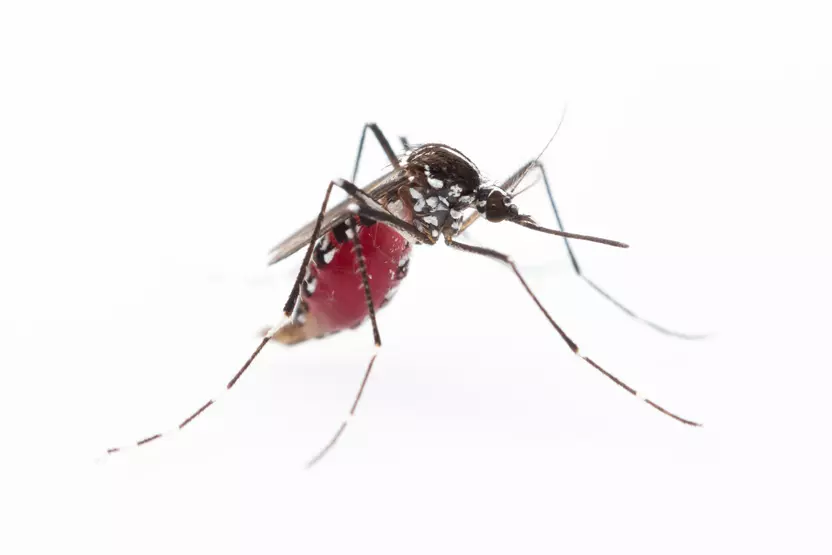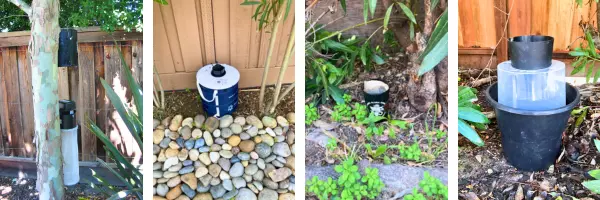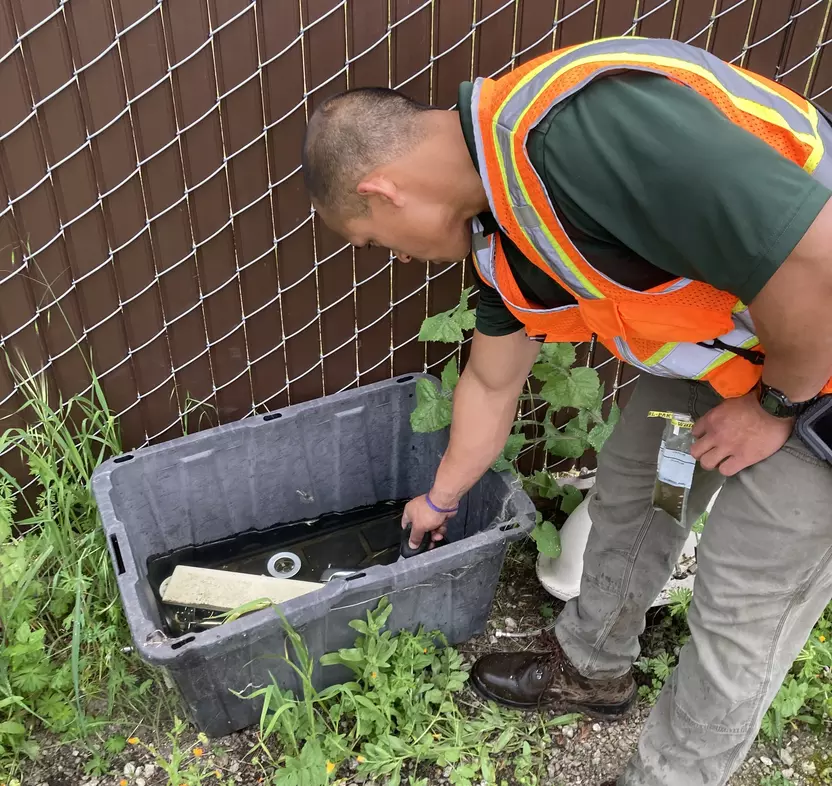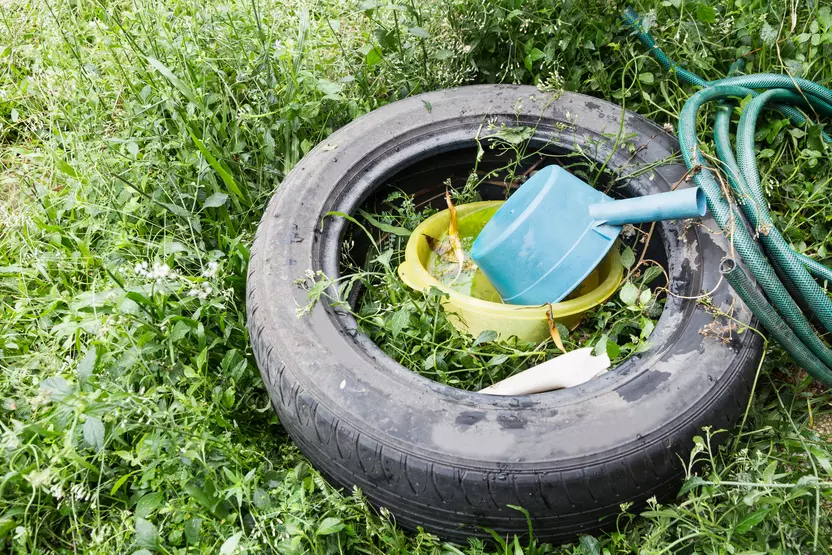Invasive Mosquitoes
Our Native Mosquitoes
The county is home to about 20 native mosquito species like the common house mosquito (Culex pipiens), the cool weather mosquito (Culiseta incidens), the Western encephalitis mosquito (Culex tarsalis), among other species. Our native mosquitoes generally bite during dusk and dawn and transmit diseases like West Nile virus, Western equine encephalitis, and St. Louis encephalitis.
Invasive Aedes Mosquitoes
Invasive Aedes aegypti (pronounced AY-dees ah-JIP-tie) mosquitoes are native to the tropical and subtropical areas of the world. Because they are not native to California, they don't thrive in the state's natural areas, but they do live and thrive in cities and backyards near people. They have expanded their infestations worldwide in recent years.

Over the last decade, these mosquitoes have spread throughout warmer regions in California and are currently detected in 19 counties. In 2022, two Aedes aegypti mosquitoes were detected in Santa Clara County, and we took an aggressive approach to containing and monitoring for the presence of the invasive mosquito. We did not detect any additional invasive Aedes mosquitoes until March 2024, when we discovered four adult female Aedes aegypti in East San José.
As of April 29, 2024, seven adult Aedes aegypti mosquitoes have been detected on Machado Lane near Story Road in East San José. We are enhancing our surveillance to determine the spread of the invasive mosquito.
This mosquito is of special concern because it has the potential to transmit several diseases that are not currently in the county, including Zika, dengue, yellow fever, and chikungunya. These mosquitoes can be easily transported to areas they are not established in via their eggs glued to plants like lucky bamboo and/or tires, or even through cars as they follow you inside. We routinely respond to travel cases from travelers returning to the county who are harboring these viruses.
Aedes Characteristics
- Aggressive Biters - Will bite at any time of day, generally during the day, and will follow you indoors.
- Prefer Humans - They prefer to feed on humans and will bite multiple times, generally around the ankles, leaving many large and itchy bumps. Because they like to bite humans, it increases the risk of human infection.
- Container Breeders - Aedes mosquitoes prefer to lay their eggs in small artificial sources of water like buckets, bird baths, pet dishes, plant pots and saucers, old tires, stems of plants growing in water, and around the backyard - an area where mosquito abatement/vector control districts can't easily inspect. They need very little water to lay their eggs.
- Hardy Eggs - They lay their eggs along the sides of containers, looking like thin lines of dirt. Their eggs can survive several years without water and will hatch when water is present and environmental conditions are right.
- Black and White Stripes - They are a small mosquito (about 1/4 inch) with black and white stripes on their back and legs.
- Fly Short Distances - Compared to our native mosquitoes, Aedes mosquitoes do not fly long distances, venturing less than 500 feet from where it hatches.
- Multiple Diseases - They can transmit a variety of viruses including Zika, dengue, yellow fever, and chikungunya.
- Difficult to Manage - Aedes aegypti are difficult to manage once they are established because of their ability to thrive in urban settings and their eggs' ability to survive dry conditions.
What We are Doing

We have a comprehensive surveillance and response plan in place for this mosquito species. To start, we have have increased our surveillance efforts to detect these mosquitoes by placing traps for adult mosquitoes and their eggs within 200-meters of where the four specimens were found (example of traps pictured on the right side).
In addition, we are also working directly with community members and property owners to remove sources of standing water where Aedes aegypti can lay eggs and conducting door-to-door inspections, larval control, and placing traps in front and backyards. It is very important that residents in the affected area allow us backyard access to check for mosquitoes and treat them as needed and/or allow us access to their yards for trapping purposes. If you received a flyer or door hanger from us and were not able to speak to one of our technicians, please contact us at your earliest convenience to request a free mosquito inspection to confirm the presence of invasive mosquitoes. If you are concerned about your privacy, we emphasize that our staff entering private properties are not authorized to do anything besides check for and control mosquito breeding and place mosquito traps.

When applicable, we are also using larvicides to kill immature mosquitoes in the area. Larvicides are used to kill mosquito larvae and are often based on naturally occurring materials, such as bacteria found in soils and insect growth hormones. If needed, we will also used EPA-approved adulticides to kill adult mosquitoes. Adulticides are designed to kill mosquitoes that have reached the biting stage and are used only when necessary or when urgent control measures are needed to rapidly disrupt the potential of disease transmission to humans. All larvicides and adulticides (pesticides) we use are approved by the Federal and State environmental protection agencies.
Self-Protection
Mosquito control is a community effort. We are doing everything we can to contain the spread of this invasive mosquito, but we need your help to have a successful eradication.
You can help by:

- Looking for small mosquitoes with black and white stripes on their backs and legs.
- Report mosquitoes that bite during the day and at night (even indoors).
- Look for eggs that look like tiny black seeds found on the insides of containers.
- Prevent water from accumulating in containers such as plant pots, saucers, barrels, bins, buckets, and old tires.
- Keep pet dishes, bird baths, and kiddie pools scrubbed and clean.
- Cover outdoor trash cans, toys, and recycle bins and keep items that could hold water out of the rain and away from sprinklers.
- Be sure rain barrels are properly sealed since mosquitoes can lay thousands of eggs inside them.
- Keep rain gutters free of debris.
To protect yourself from mosquito bites and mosquito-borne diseases, you can follow the steps below.
- Insect Repellents - Apply insect repellents containing EPA-registered ingredients like DEET, picaridin, IR3535, or oil of lemon eucalyptus, always following the label instructions.
- Report Mosquito Bites - Report any day-biting mosquitoes that have black and white stripes on their back and legs through one of these options:
- Call (408) 918-4770
- Email [email protected]
- Online: Submit an online service request